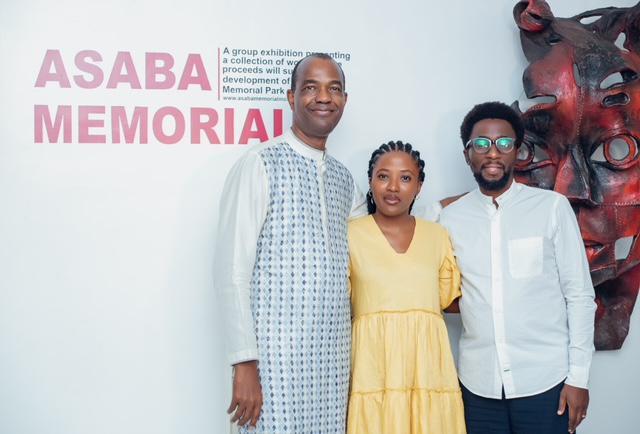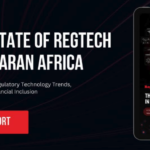

By Chukwuma Ajakah
In honour of victims of the historic Asaba Massacre of 1967, a group memorial exhibition produced by A Whitespace Creative Agency opened last Sunday, 27 November at the prestigious Red Door Gallery, Victoria Island, Lagos.
Organized as part of activities marking the establishment of a memorial park, immortalizing the victims of the Asaba pogrom, the exhibition is a sad commentary on the horrors of war and man’s inhumanity to man.
Organizers of the event, Asaba Memorial Committee in a Press Release issued through the Chairperson and Convener, Chief Chuck Nduka-Eze, the Isama Ajie of Asaba, announced that the group exhibition curated by modern and contemporary African art curator, Otsholeng Poo, commemorates the tragic events of the 1967 Asaba Massacre. The epic presentation features the iconic works of celebrated Nigerian artists, revolving around the tragic event in Nigeria’s history. Also, the committee revealed that the seminal exhibition, a novel contribution to the development of the proposed Asaba Memorial Park Monument will feature over 20 artists, including:
Prof. Bruce Onobrakpeya, Ben Enwonwu, Olumide Onadipe, Victor Ehikamenor, Kelani Abass, Sadiq Ajibola Williams, Joseph Ogbeinde, Kainebi Osahenye, Duke Asidere, Adiza Nzekwe, Ade Bakare, Enotie Ogbebor, Juliet Ezenwa Maje-Perce, Lekan Onobanjo, Philip Nzekwe, Kanye Okeke, Elizabeth Ekpetorson, Marcia Martins DaRosa, Anthony Nwalupue, Tiffany-Annabelle, Naomi Oyeniyi, Ayoola Gbolahan and Prince Orlu.
The exhibition features insightful emblematic representations of the1967 tragedy, encapsulating the emotional complexities of a hitherto forgotten peaceful community with emphasis on the damages inflicted on the psyche of the people by proponents of the massacre and the Nigerian civil war.
The artworks also interrogate some assumptions about the sad event, challenging visitors to spare thoughts on the pathetic plight of survivors of all the casualties, including young widows, women and children of the soldiers who risked their own lives in a bid to save others.
Viewing time for the exhibition tagged, “Asaba Memorial Exhibition: Inspiring Remembrance and Communal Healing Through Art” is 11: 00 am-6:00 p.m. from Tuesday through Saturday.
The proposed Asaba Memorial Park is to serve as a cultural monument in honour of the victims of the Asaba massacre.
Artworks being featured at the event include: “IN MEMORIAM”(2022), a monumental canvas piece-ornamented with the names of some of the victims, by 12-year-old artist, Kanye Okeke, Victor Ehikhamanor’s Black Peace (2022), a body of work from Enotie Ogbebor, son of a senior Nigerian military officer who provided an eye-witness account of the atrocities witnessed in Asaba, Ade Bakare’s Ogbueshi – Guipure cotton lace with red paint and soil, depicting the fate of Ogbueshi Leonard Nwanonye Okogwu, the father of Asaba-born Former First Lady, Mrs. Mariam Babangida, Ben Enwonwu’s painting, portraying the horrors of the Nigerian Civil War, “War Dreams” (1967) and Bruce Onobrakpeya’s “Ayo Players” (1972).
While explicating the prospects of the exhibition, Curator Otsholeng Poo said, “As a South African who calls Nigeria home, I understand the importance of this exhibition on a very personal level. I am inspired by the people of Asaba’s continued survival and resounding call for the Massacre to be given its proper place in the telling of Nigeria’s history. I’m also hopeful that as this project gains supporters from across the continent and the world, we can keep telling the story of Asaba through art and community.”. The curator also expressed optimism that the project would attract global attention, saying: “As the exhibition travels across locations, we intend to invite more artists’ contributions and keep expanding the Park’s collection.”
Appraising the relevance of the seminal exhibition to Nigeria in particular and the global community at large. Elizabeth Bird and Fraser Ottanelli, co-authors of the book, The Asaba Massacre: Trauma, Memory and the Nigerian Civil War, said: “This new initiative will take the memorial process to a new level, bringing visibility throughout the nation and the continent. This new visibility gives hope that Asaba will finally see an official acknowledgement of responsibility for its suffering. But, above it, this spectacular memorial will honour those who died, ensuring they not be forgotten and leading the way to a better future. “
The Convener and Chairman of the Asaba Memorial Committee, Chief Nduka-Eze described art as a veritable tool for creating awareness about crucial societal issues such as the 1967 Asaba pogrom. “To date, there has been no proper explanation or official apology from the Federal Government of Nigeria for the humanitarian crime,” he said, adding: “We encourage everyone to come and explore the exhibition. It will challenge people not only to ask, ‘what could have been done?’ but also, ‘what can we do?’ This is the first step to creating a memorial site that is accessible and dignified in its representation to honour the victims, a place that will be a community symbol of all the lives lost and extend to encompass a cultural and recreational attraction for both local and international tourists.”
According to Chief Nduka-Eze, the exhibition is part of a series of comomorative activities geared towards “the development of a permanent world-class physical space as nature park, monument, artistic and cultural centre in honour of all those who lost their lives and were displaced by the Asaba massacre.” He further revealed that the Memorial Park will have 1,000 foundational trees symbolically representing those who died during the massacre and that the initiative is a legacy project that will in addition to giving due homage to the victims and their families, will serve as a place of reflection on healing for ‘Asabans’ and other Nigerians in general.
In his goodwill message, Prof. Ibrahim Pam, Head of GCF’s United Nations Independent Integrity Unit, stressed the eternal value of the initiative, saying: “The Asaba Massacre Memorial Monument Project as a memorialization initiative could become that essential catalyst for the promotion of national reconciliation that is anchored on an honest discussion of historical grievance, that leads to acknowledgement and recompense, and promotes genuine appeasement and national unity.”
In similar vein, Professor of Media and Criminal Justice, University of Bedfordshire and former BBC Home Affairs Correspondent, Jon Silverman observed that “It is right that it should be commemorated, and the victims honoured, not to fan the flames of ethnic tension but as a simple necessity: to leave a permanent physical record of inhumanity for this and future generations to reflect on and ensure that it is never repeated.”
Chief Chuck Nduka-Eze, an entrepreneur, lawyer and arts enthusiast had represented Anioma Community at the special panel of 1999 the Human Rights Violation Investigation Commission of Nigeria where the subject of genocide of the people during the Nigerian Civil War was a topical issue.
The steering Committee also has other prominent members such as Chief (Dr) Ben Okonta, the Ojiba of Asaba, Chief (Prof) Victor Izegbu, Orjiaku of Asaba, Ogbueshi Chike Ogeah, Ogbueshi Ken Odogwu, Ms Ngozi Edozien and Ogbueshi Uche Nwajei, the Onoi of Asaba.
The post Healing through art @ Asaba Memorial Exhibition appeared first on Vanguard News.





